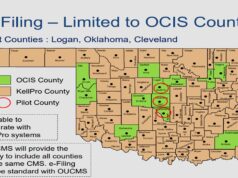

In the Nov. 3 election, 710,379 Oklahomans marked a box indicating their preference for straight-party voting in every race on their ballot without having to select each individual candidate.
Along with Alabama, Indiana, Kentucky, Michigan and South Carolina, Oklahoma is one of only six states that have a “straight party” or “straight ticket” option on ballots.
According to Sen. J.J. Dossett (D-Owasso), straight-party voting served a purpose in the early days of the state, when information on individual candidates was not widely available and people often had to make decisions along party lines.
Now, Dossett and some argue that voters have access to information on candidates, relieving the need for the box. They fear the straight-ticket option discourages voters from paying close attention to electoral races and leads to them to be haphazard in completing a civic duty.
Others say the straight-party option is convenient and doesn’t actually affect the way people vote.
But while many states have gotten rid of the straight-party option in recent years, Oklahoma doesn’t seem likely to make a change anytime soon.
An unpredictable debate
The straight-party box has been on the Oklahoma general election ballot since statehood. In the old days, each party even had an associated image to help people understand what party they were voting for.
Straight Party voting has a long tradition in Oklahoma. Here is what it looked like for the 1907 “statehood” elections. pic.twitter.com/ljRhJdmzlM
— Oklahoma State Election Board (@OKelections) November 6, 2020
Many states have gotten rid of straight-party voting in recent years. In 2007, 17 states had straight-party voting. All but six have since done away with it.
But the trend has also been met with opposition — though that opposition does not always fall along predictable party lines.
After the Michigan Legislature voted to end the practice in 2015 — a measure supported by Republicans — opponents argued the ban disproportionally discriminated against African-American voters. The ban was eventually overturned in court.
Later that same year in New Mexico, there was an attempt to put the straight-party option on the ballot for the first time since 2012. There, however, opponents believed the addition of the ballot option would benefit the Democratic Party, and the move was blocked in court.
Texas is one of the latest states to get rid of straight-ticket voting, and the 2020 election was the first time the option didn’t appear on the ballot.
Although there’s no way to know how people would have voted if the option were still on the ballot, according to the Texas Tribune, it may of been the reason two Republican state House members were able to keep their seats in a Dallas County, where Biden won by nearly 32 percentage points.
Straight-ticket voting is a popular option in Oklahoma. In the Nov. 3 election, President Donald Trump won 1,020,280 votes in Oklahoma. Of those, 502,411 were from Oklahomans who filled in the Republican straight-party box. President-elect Joe Biden took 503,890 total votes, 198,269 on them from straight-party Democratic votes.
The arguments for and against
One concern about straight-party voting is that it allows high-profile state or national races effectively to determine the result of smaller local races.
In Oklahoma, straight-party voting used to work in Democrats’ favor, as it was instituted when Democrats were the state’s majority party. But when the party balance shifted in the 2000s, the straight-party option started working against down-ticket Democrats.
Alicia Andrews, the chairwoman of the Oklahoma Democratic Party, said she doesn’t believe Oklahomans are being properly represented with straight-party voting. She said it’s important for people to know who they vote for and that the straight-party option discourages voters from getting to know individual candidates.
“I think that this election proved that,” Andrews said. “Candidates don’t even have to run. They just have to have the right letter by their name.”
Former Republican Rep. Mike Turner argues, however, said that although the straight-party option might somewhat reduce engagement with local races, eliminating it wouldn’t significantly change they way people vote.
“Most voters know who they’re voting for,” Turner said. “They can still see the ‘R’ or the ‘D’ next to [candidates’] name.”
It’s true that people can and do vote straight party even if it takes filling in more than one box. Last month, Pew Research reported data showing that few voters split their ballots. For instance, only 4 percent of registered voters planned on supporting Trump or Biden and a Senate candidate from the opposing party.
Oklahoma’s attempts to change
As in other states, there have been efforts to get rid of the straight-party box on Oklahoma’s ballots, but those efforts have had trouble gaining momentum.
Last year, Dossett wrote SB 51 to remove the straight-party option from the state’s ballots.
“I just feel like it’s a common-sense modernization to say that each voter has to select the person who is going to be representing them. That’s all this would do,” Dossett said. “You could still all vote for one party.”
But the bill never even received a vote in committee.
“It’s just really hard to get traction. Because, honestly, if I’m an elected person and straight-party voting helps me get elected, then it’s not something I want to get rid of,” Dossett said. “I want to keep giving voters that choice because it’s in my benefit.”
Dossett said he plans on submitting a similar proposal again in future legislative sessions, hoping he can get a committee hearing.




















